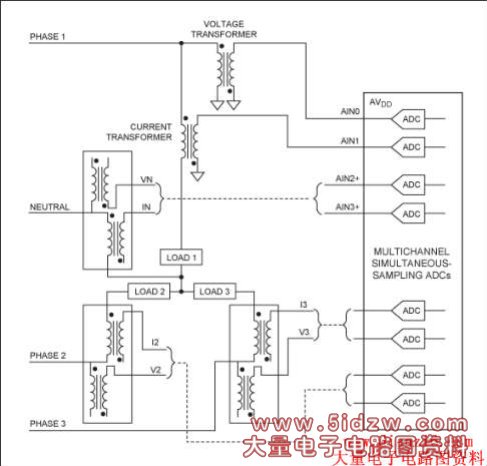Reduce System Cost for Advanced Powerline Monitoring by Leveraging High-Performance, Simultaneous-Sampling ADCs
Abstract: Rising power demands and a focus on energy conservation are driving increased investment in the global power-delivery infrastructure. As a result, advanced powerline monitoring systems have become a critical element of the new "smart grids" for both single- and multiphase applications. With system performance requirements growing more stringent, designers are turning to simultaneous-sampling, multichannel, high-performance ADCs for their powerline monitoring or multichannel SCADA (supervisory control and data acquisition) systems.
A similar article appeared on the EDN Magazine website on August 18, 2009.
Introduction
Advanced powerline monitoring systems combine power-supply monitoring, load balancing, protection, and metering functions in one system. This approach allows the power utilities to deliver, and the customers to consume, grid power more efficiently. Along with efficient delivery, the advanced powerline monitoring systems predict maintenance needs; detect and respond to fault conditions; record and allow for dynamic load balancing and energy conservation; monitor (and control) the quality of power delivery; and help protect equipment.To implement these monitoring systems, ADCs (analog-to-digital converters) are needed to monitor the voltage and current on multiple phases. However, to meet the stringent requirements of the various standards and to measure and optimize power-factor losses, these converters must be synchronized to ensure that they sample three phases (plus neutral) simultaneously. Synchronizing individual converters can be difficult, so vendors offer multiple simultaneous-sampling ADCs in a single package. If a more highly integrated solution is needed, another option is to integrate the simultaneous-sampling converters in a custom ASIC.
Performance Measurements—Local Standards and International Requirements
The development and widespread adoption of advanced powerline monitoring systems is complex due to varying international standards defining the precision of energy measurement. The measurement characteristics of the delivered energy must comply with local standards or international requirements. The EU (European Union) standards EN 50160, IEC 62053, and IEC 61850 dictate the minimum accuracy needed for a modern multichannel ADC system used in power-system monitoring and metering. Powerline monitoring is also impacted by the increasingly stringent accuracy requirements associated with real-time power-delivery monitoring, fault detection and protection, and dynamic load balancing. As an example, the EU standard IEC 62053 Class 0.2 (which is increasingly used as a common standard worldwide) requires meter precision to be 0.2% of nominal current and voltage. For power-factor accuracy measurement, phase matching should be 0.1% or better.Not only is the minimum accuracy specified, but international and local standards also dictate the sample rate needed for a modern system used in powerline monitoring and metering. There is now a need for rigorous analysis of multiple high-order harmonics of the AC supply and for detection of high-speed fault conditions such as instantaneous spikes and brownouts. Consequently, these applications typically require accurate, simultaneous multichannel measurement over a wide dynamic range of up to 90dB with a sample rate of 16ksps or higher.
Many countries around the globe have adopted versions of the EU standards, so these standards serve as a good example of the measurement requirements which the system must meet. Table 1 summarizes the EN 50160 requirements.
Table 1. EN 50160 Energy Specifications
| Supply Voltage Phenomenon | Acceptable Limits | Measurement Interval | Monitor Period | Acceptance Percentage (%) |
| Grid Frequency | 49.5Hz to 50.5Hz, 47Hz to 52Hz | 10s | 1 week | 95, 100 |
| Slow Voltage Changes | 230V ±10% | 10min | 1 week | 95 |
| Voltage Sags or Dips (≤ 1min) | 10 to 1000 times per year (under 85% of nominal) | 10ms | 1 year | 100 |
| Short Interruptions (≤ 3min) | 10 to 100 times per year (under 1% of nominal) | 10ms | 1 year | 100 |
| Accidental, Long Interruptions (> 3min) | 10 to 50 times per year (under 1% of nominal) | 10ms | 1 year | 100 |
| Temporary Overvoltage (Line-to-Ground) | Mostly < 1.5kV | 10ms | — | 100 |
| Transient Overvoltages (Line-to-Ground) | Mostly < 6kV | — | — | 100 |
| Voltage Unbalance | Mostly 2%, but occasionally 3% | 10min | 1 week | 95 |
| Harmonic Voltages | 8% THD | 10min | 1 week | 95 |
For the harmonic voltage, the EN 50160 mandates measurement up to the 25th-order harmonic of 50Hz/60Hz voltages. However, for various nonlinear loads, such as inductive motors and switching power-supply drives, measurements must be done for up to the 127th-order harmonic of 50Hz/60Hz voltage supply.
It is also important to note that emerging standards like IEC61850 recommend the recording of power-system transient events with 256 samples per AC cycle or higher.
A Typical Power-Grid Monitoring Application
Standard throughout the world, 3-phase power is distributed using what is called a "wye connection." The term "wye" refers to three voltages that are offset in phase from each other by one-third of a cycle (120°). A fourth wire, or neutral line, is often used to accommodate unbalanced loads. If loads on each of the three phases are equal, the system is balanced and no current flows though the neutral line. A typical power-grid monitoring scheme is shown in Figure 1. Each phase's power (voltage and current) measurements are obtained by a current transformer (CT) and a voltage transformer (a potential transformer, PT, in power-distribution nomenclature). The complete system comprises four such pairs (one pair for each of the three phases plus neutral). ,Reduce System Cost for Advance
,Reduce System Cost for Advance